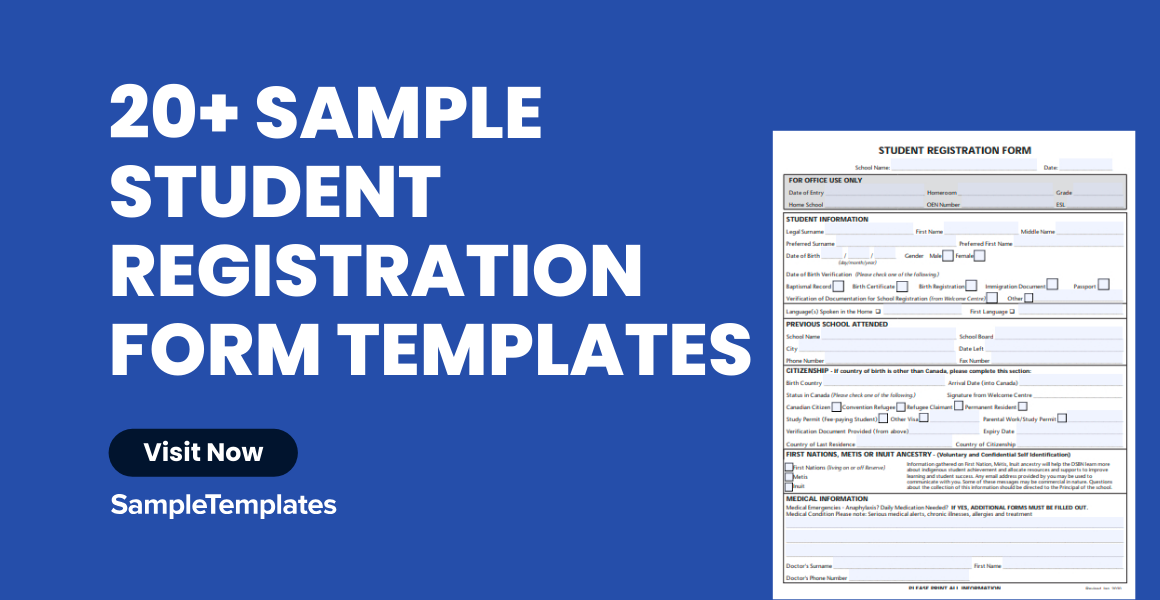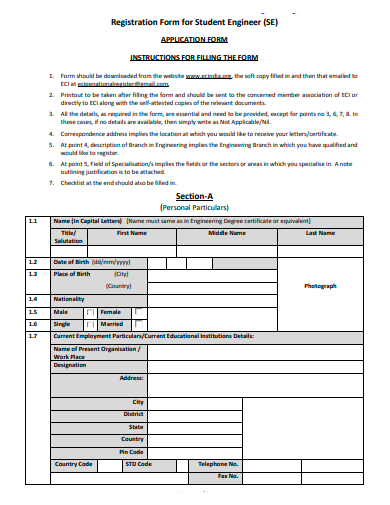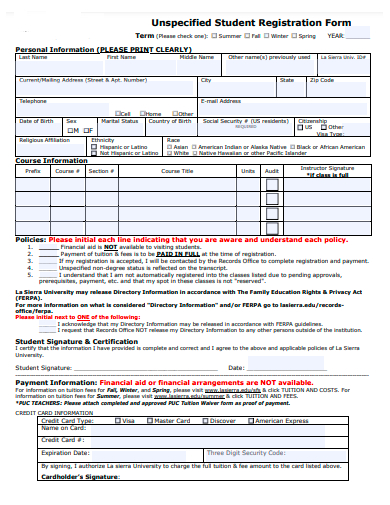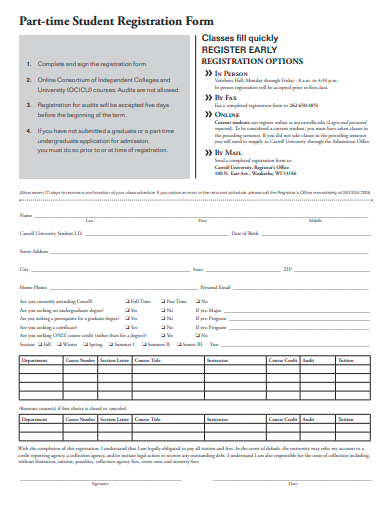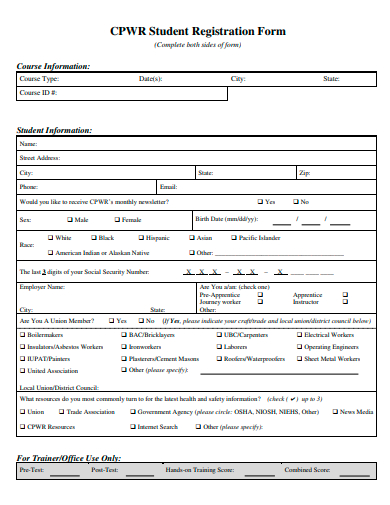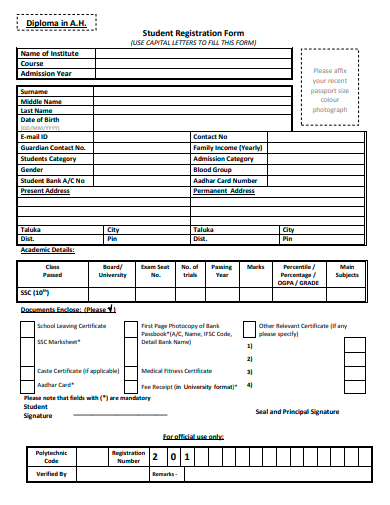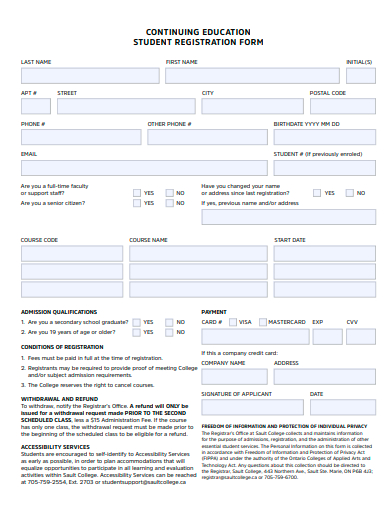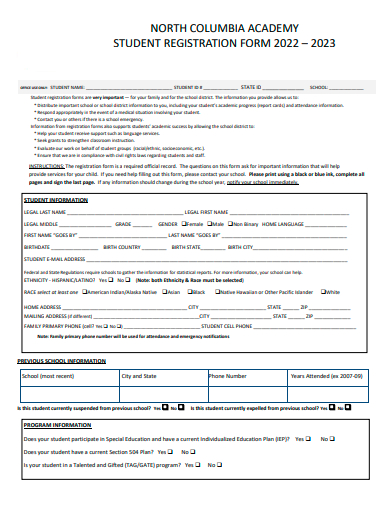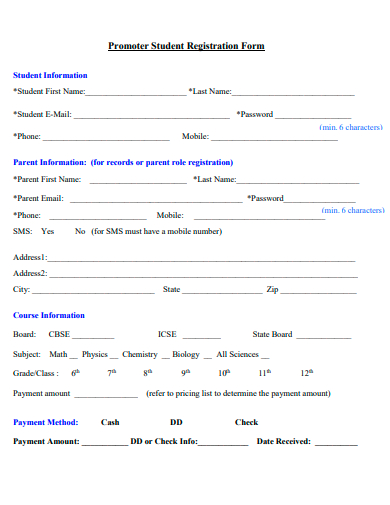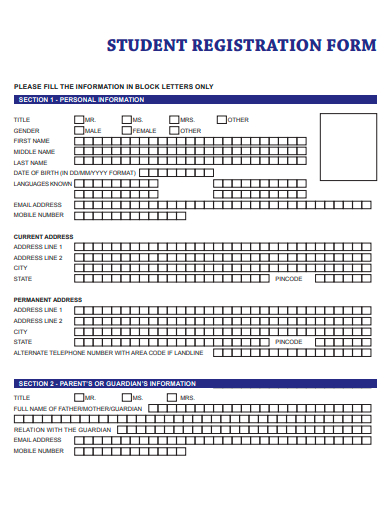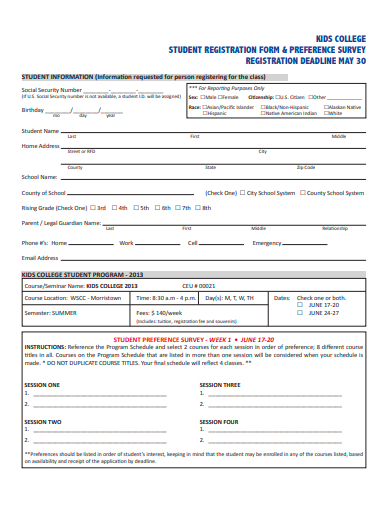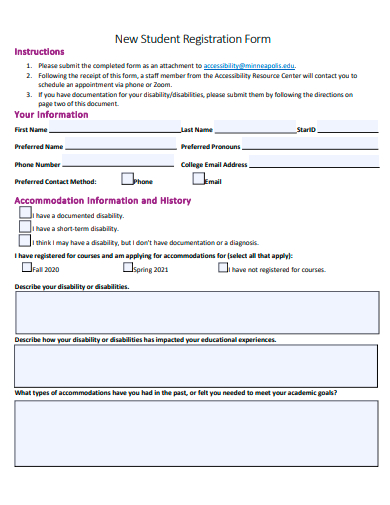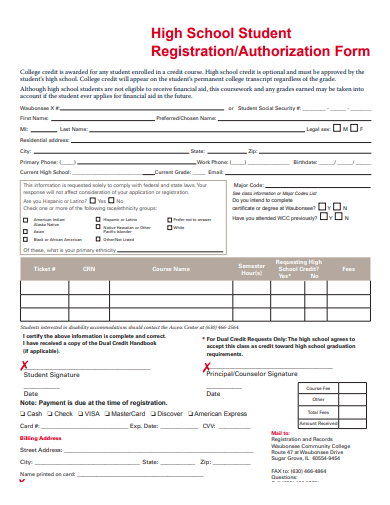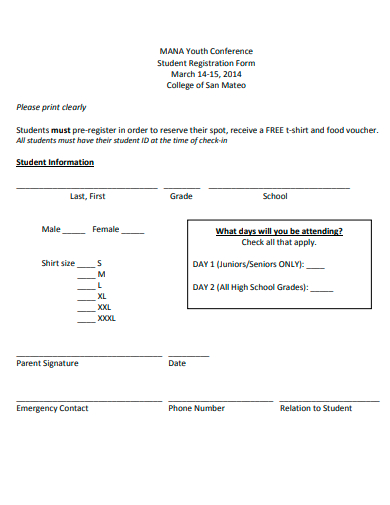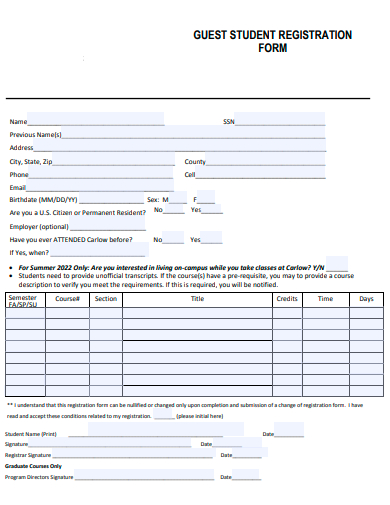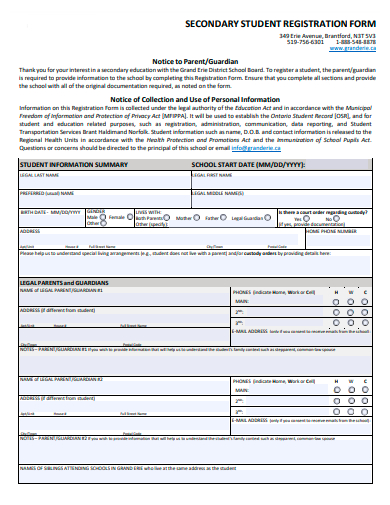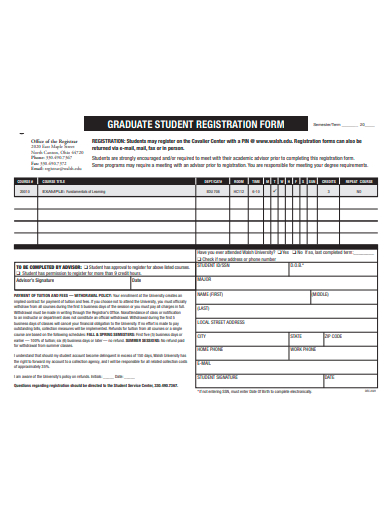Introducing our Sample Student Registration Template, complete with a state of the art application form. This blend of design and functionality ensures that institutions seamlessly gather every essential detail. Gone are the days of tedious paperwork and missing information. With our integrated application form, both students and educational bodies can experience a streamlined enrollment process. Dive into a world where precision meets convenience, and watch as each student’s journey unfolds effortlessly. Experience the modern approach to student registration now!
20+ Student Registration Form Samples
1. Student Registration Form Template
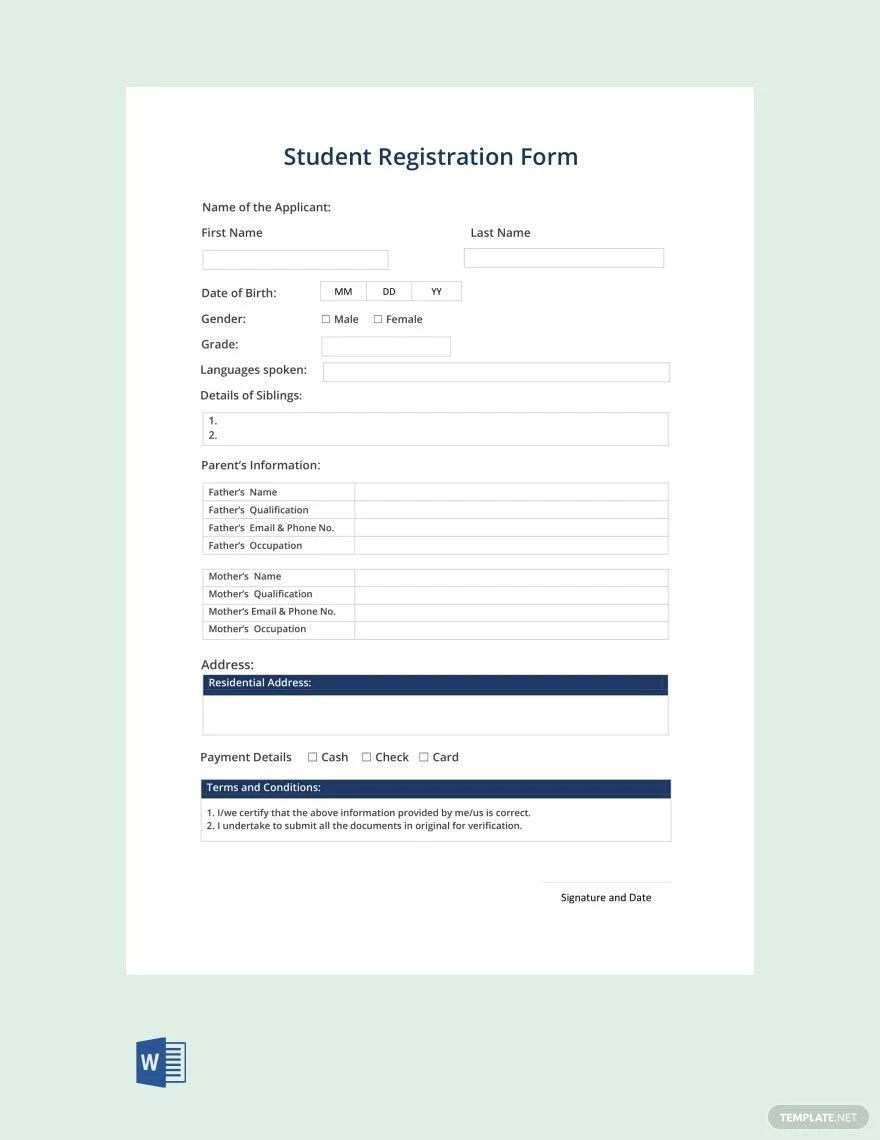
2. New Student Registration Form Template
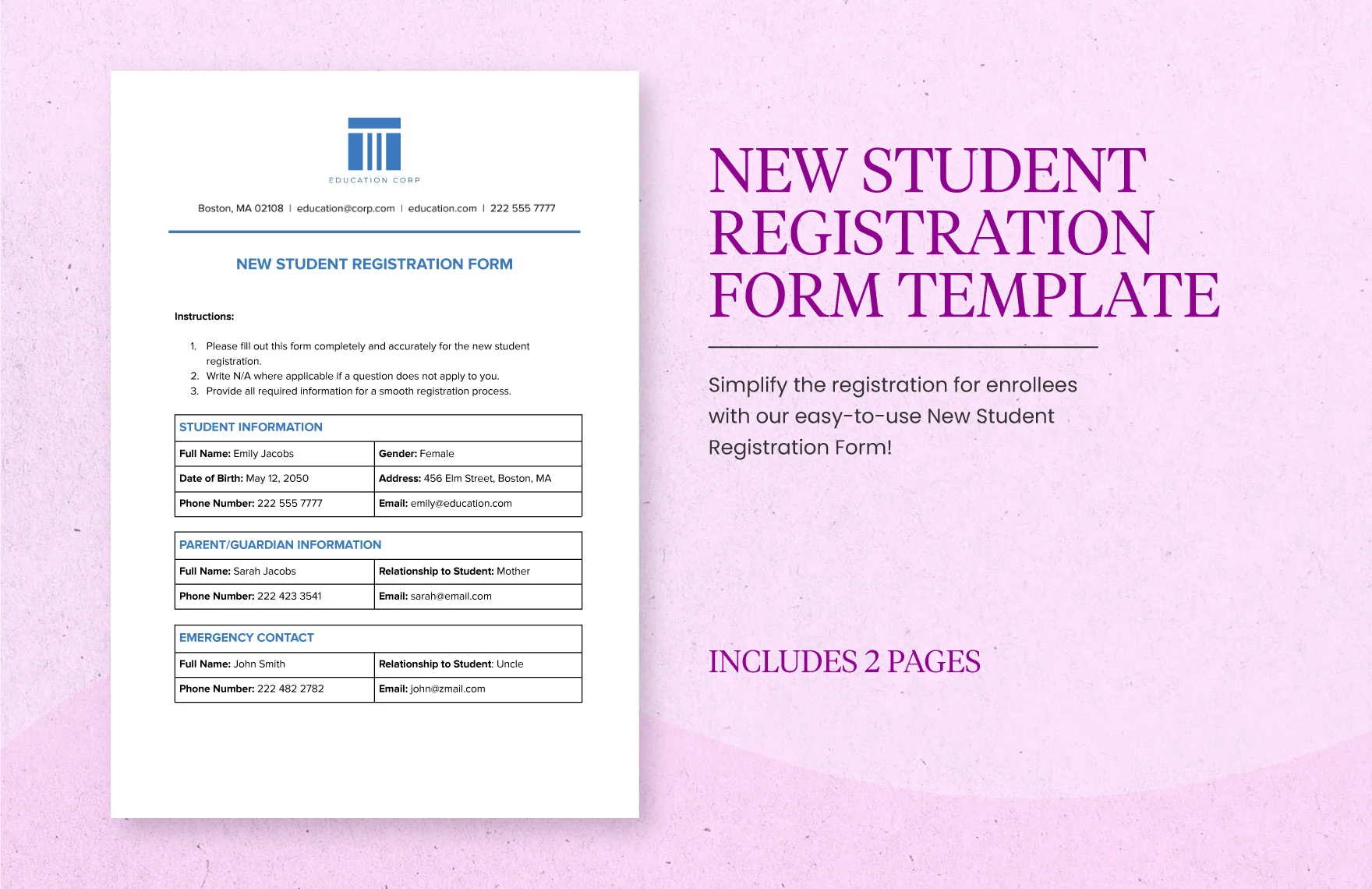
3. Non Degree Student Registration Form Template
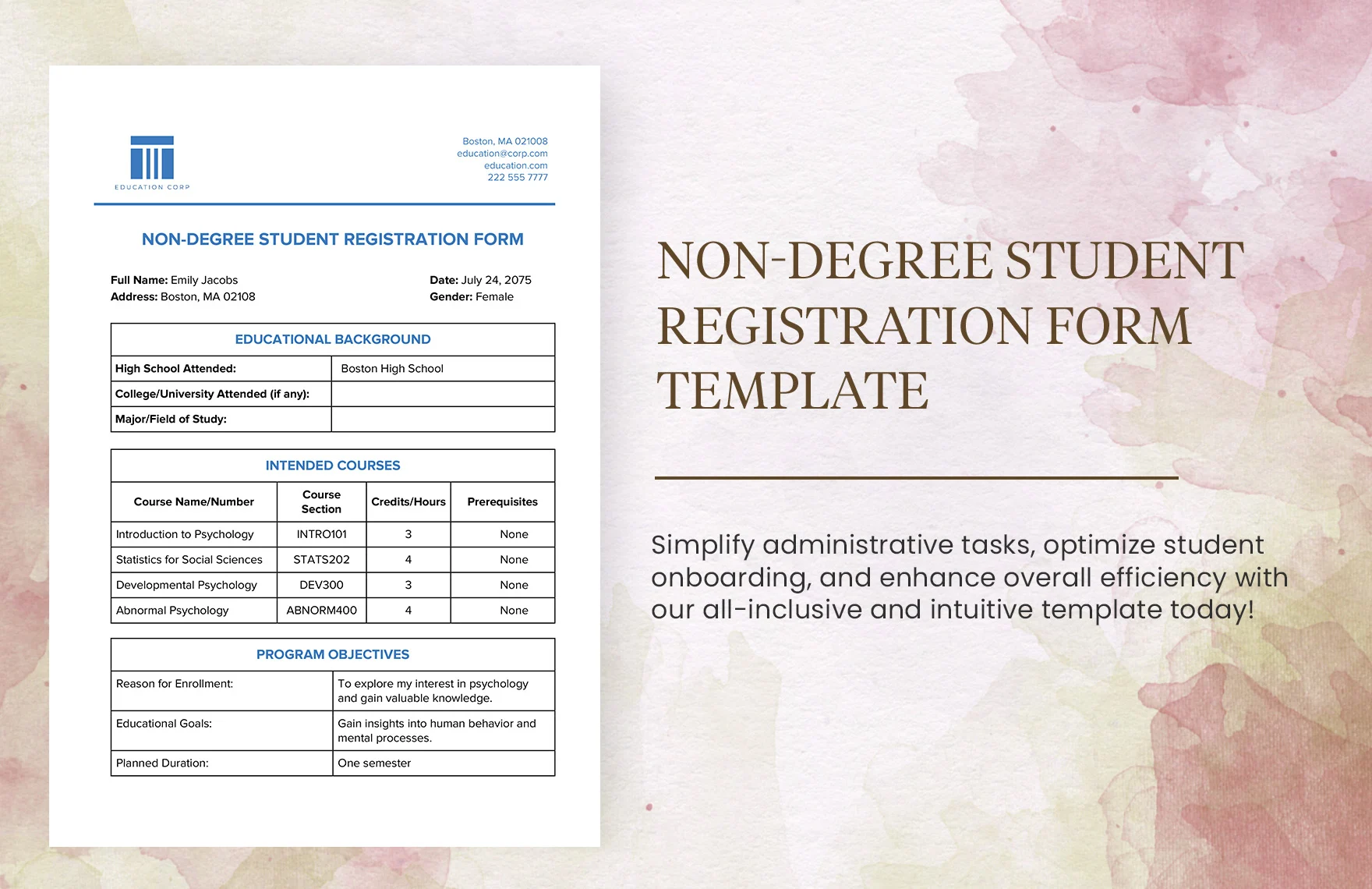
4. Engineer Student Registration Form Template
5. Basic Student Registration Form Template
6. Sample Unspecified Student Registration Form Template
How to Create a Student Registration Form
Creating a student registration form is essential for educational institutions aiming to efficiently collect vital details from their enrollees. An effective form not only simplifies the enrollment process for students but also streamlines administrative tasks. Here’s a guide to crafting a comprehensive student registration form:
Determine the Purpose:
Before diving in, it’s crucial to establish the objective of your form. Is it for a specific academic year enrollment, a short workshop, an extracurricular club, or a special event? Your purpose will guide the information you’ll need to gather.
Choose a Platform:
There’s a myriad of platforms available for form creation, from simple ones like Google Forms and Microsoft Forms to more specialized tools such as JotForm and Formstack. Many offer customizable templates, making the process even smoother. If you’re tech-savvy, creating a personalized form using HTML and CSS is another option.
Design with Care:
Prioritize a clean layout. It’s imperative in today’s digital age to ensure the form is mobile-responsive, as a significant number of users might access it via mobile devices. Aim for a user-friendly design with intuitive instructions to enhance the user experience.
Include Essential Fields:
This typically comprises personal details (e.g., name, date of birth, nationality), contact information, academic data (like previous schools or desired courses), emergency contact details, and any special requirements or medical information the school should be aware of.
Consider Optional Fields:
Depending on the institution’s needs, you might want to add fields related to hobbies, extracurricular activities, or other details that could offer insights into the student’s interests and strengths.
Prioritize Privacy and Consent:
It’s vital to have a section dedicated to data privacy and consent, especially if the registrants are minors. This is where students or their guardians grant permission for the institution to store and process their information. Always align with prevailing data protection regulations when handling personal data.
Clear Instructions are Key:
For any fields that might be ambiguous, provide concise tooltips or instructions. If specific documents or particular details are required, mention the desired format or offer clear guidelines.
Test Before Launch:
Always run a pilot test. Check for potential issues, unclear sections, or technical glitches. A usability test, where you ask a few individuals to complete the form and share their experience, can provide valuable insights.
Embed or Distribute the Form:
Once you’re satisfied with the form, either embed it on the institution’s official website or share its link through various communication channels, such as emails or social media.
Stay Updated:
As times change, so do the requirements of both students and institutions. Periodically review the registration form to ensure it’s up-to-date and caters to contemporary needs.
In essence, the student registration form is the initial interaction point between students and educational bodies. A well-structured, user-centric form can foster a positive rapport from the outset, setting the stage for a successful educational journey.
7. Part-time Student Registration Form Template
8. Printable Student Registration Form Template
9. Diploma Student Registration Form Template
10. Continuing Education Student Registration Form Template
11. Sample Academy Student Registration Form Template
12. Promoter Student Registration Form Template
13. Student Registration Form in PDF
The Use of a Student Registration Form
In the world of academia, the student registration form plays a pivotal role. It is more than just a document; it’s a bridge connecting students, their guardians, and educational institutions. Here’s a deep dive into the importance and multifaceted use of a student registration form.
Central Repository of Information:
At its core, the student registration form is an efficient way for institutions to gather, store, and manage vital data about their students. This data can range from basic personal details to more specific academic and medical histories. With such a form, schools, colleges, and universities can have a consolidated and organized pool of information that can be easily accessed and updated.
Streamlining Administrative Processes:
One of the primary challenges faced by educational institutions, especially during enrollment seasons, is handling the massive inflow of student data. The registration form ensures that there’s a standardized method of collecting information, reducing discrepancies and errors. This streamlined approach not only saves time but also ensures accuracy in the student management system.
Facilitating Communication:
Having accurate contact details of students and their guardians is imperative. Whether it’s sending out academic reports, announcing school events, or notifying about sudden changes in schedule, the contact information from the registration form enables smooth and consistent communication.
Understanding Student Needs:
Often, registration forms include sections where students or their guardians can specify special requirements, medical conditions, or learning needs. This information is invaluable for institutions to provide necessary accommodations, ensuring that every student has an optimal learning environment.
Planning and Resource Allocation:
The data gleaned from registration forms can assist schools in forecasting and planning. Understanding the demographic spread, academic interests, and even transportation needs can help institutions make informed decisions about class allocations, hiring staff, and provisioning resources.
Legal and Medical Safeguards:
In the unfortunate event of an emergency, having immediate access to a student’s medical history, emergency contact form information, and other pertinent details can be life-saving. Additionally, the signed declarations and consents on registration forms serve as legal safeguards for institutions, ensuring they have the necessary permissions for various academic and extracurricular activities.
Building a Community:
Many registration forms also gather information on a student’s interests, hobbies, and extracurricular preferences. Such data can be instrumental for institutions aiming to foster a sense of community. Schools can organize clubs, workshops, and events based on collective interests, ensuring higher participation and engagement levels.
Maintaining Academic Continuity:
For institutions offering varied courses or grade levels, the academic details provided in the registration form ensure continuity in a student’s education journey. Schools can understand a student’s previous academic background, which can guide placement in the right class or course, ensuring seamless progression.
the student registration form is an indispensable tool in the modern educational landscape. Its multifunctional nature serves not just as an administrative necessity but also as a compass guiding institutions in offering a well-rounded, comprehensive, and inclusive educational experience. By understanding its myriad uses, schools and colleges can harness its full potential, ensuring they cater to every student’s unique needs while also optimizing their internal processes.
14. Sample College Student Registration Form Template
15. New Student Registration Form Template
16. High School Student Registration Authorization Form Template
17. Youth Conference Student Registration Form Template
18. Sample Guest Student Registration Form Template
19. Secondary Student Registration Form Template
20. Graduate Student Registration Form Template
21. Student Registration Form in DOC
Who Needs a Student Registration Form?
In the vast arena of education and learning, the student registration form is not a mere piece of paper or a digital document; it’s a vital tool for information gathering and management. But who truly requires this tool? Let’s delve into the diverse entities and scenarios that call for the utilization of a student registration form.
Educational Institutions:
The most apparent users are, of course, educational establishments.
Schools: Whether elementary, middle, or high schools, every academic year witnesses a new influx of students. A registration form helps these institutions capture essential details about the incoming students, ensuring they can cater to their academic and non-academic needs effectively.
Colleges and Universities: Higher education institutions, with their varied courses, departments, and elective subjects, necessitate detailed registration forms to correctly place students in their chosen fields of study.
Special Education Centers: These institutions require more detailed information about students to ensure they can provide the necessary accommodations and support, making registration forms especially vital.
Training and Workshop Organizers:
Entities or individuals who conduct short-term courses, training programs, or workshops also benefit immensely from student registration forms. These forms help gauge the background knowledge of participants, their expectations, and ensure the content delivered is tailored to the audience.
Online Course Platforms:
With the surge in online learning, platforms offering MOOCs (Massive Open Online Courses) or specialized courses need student registration forms. These forms help in creating user profiles, recommending courses based on interests, and facilitating better user engagement.
Extracurricular Activity Centers:
Centers that offer activities such as dance, music, martial arts, or art classes often require basic information about their students. Knowing age, previous experience, or any special needs helps instructors tailor their approach accordingly.
Summer Camps and After-School Programs:
Organizers of summer camps or after-school enrichment programs use registration forms to gather details about participants. Information like dietary restrictions, medical conditions, or emergency contact numbers is especially crucial in these settings.
Sports Leagues and Teams:
To place students in appropriate age groups or skill levels, sports organizations and teams utilize registration forms. These forms can also capture details about previous training, medical fitness, and emergency contacts.
Government and Non-Profit Initiatives:
Government-run educational initiatives or programs by NGOs aiming at skill development, literacy drives, or community classes also employ student registration forms. These forms aid in understanding the demographic they’re serving and ensure resources are allocated effectively.
Research and Academic Competitions:
Organizers of academic competitions, Olympiads, or research projects for students require registration forms to ensure eligibility, assign mentors, or provide necessary resources.
In essence, anyone or any entity aiming to provide an educational experience, be it formal schooling, skill development, recreational learning, or competitive challenges, finds value in a student registration form. The form serves as the first point of connection, ensuring the educators or organizers are well-equipped with information to provide a tailored, efficient, and enriching learning journey for every participant.
Related Posts
Sample Sworn Affidavit Forms
Vehicle Inspection Forms Samples & Templates
Sample Employee Advance Forms
Sample Child Travel Consent Forms
Sample Testimonial Request Forms
Sample Employee Details Forms
Sample Divorce Forms
Sample Attestation Forms
Employee Performance Appraisal Form Templates
FREE 9+ Sample Presentation Evaluation Forms in MS Word
FREE 10+ School Admission Form Samples & Templates in MS Word | PDF
FREE 30+ Patient Consent Form Samples in PDF | MS Word
FREE 10+ Sample Sign Off Form Templates in PDF | MS Word
FREE 11+ Sample Medical Consultation Forms in PDF | MS Word
FREE 8+ Sample Donation Forms in PDF | MS Word
